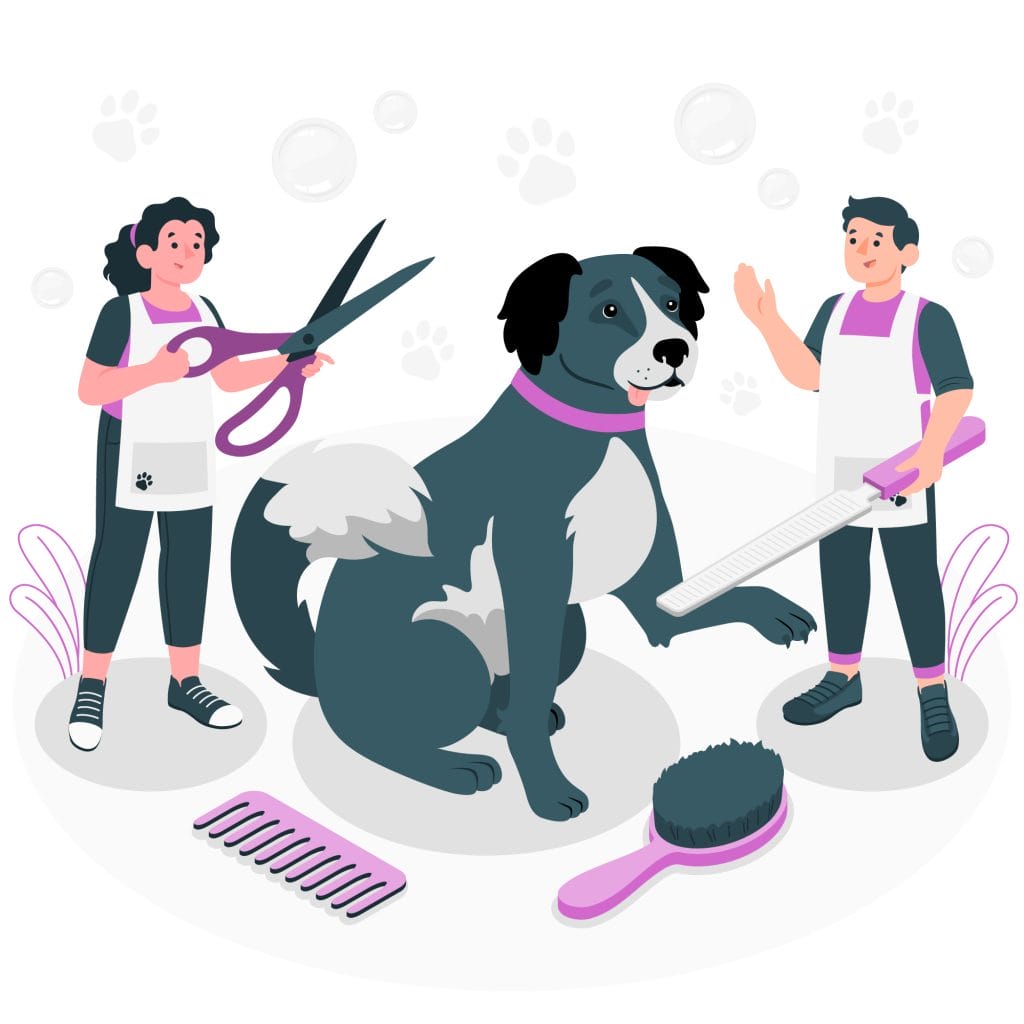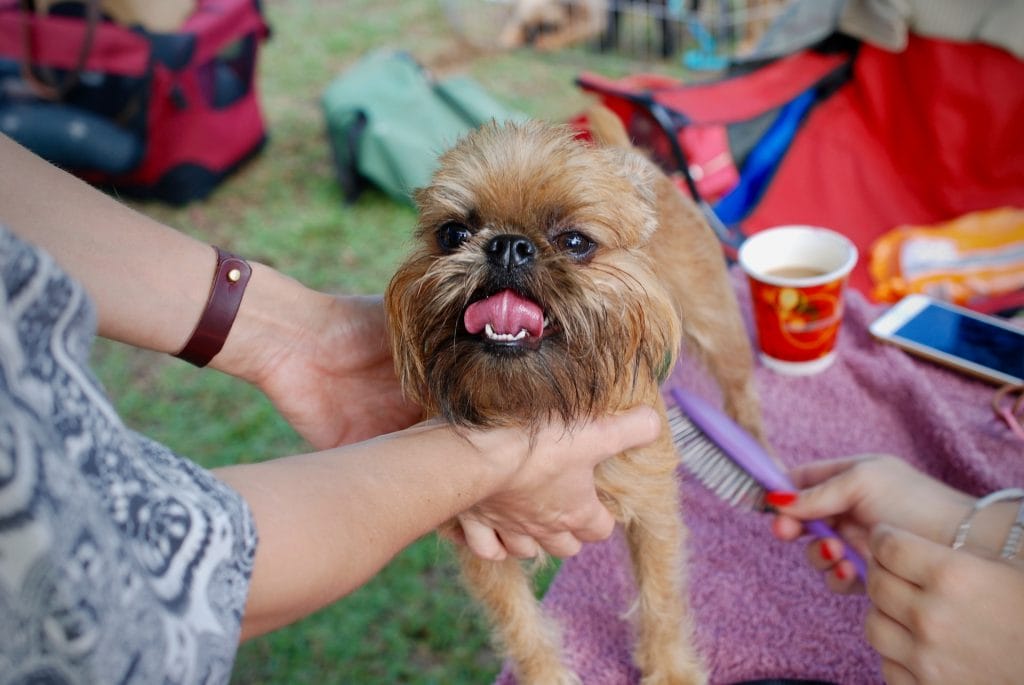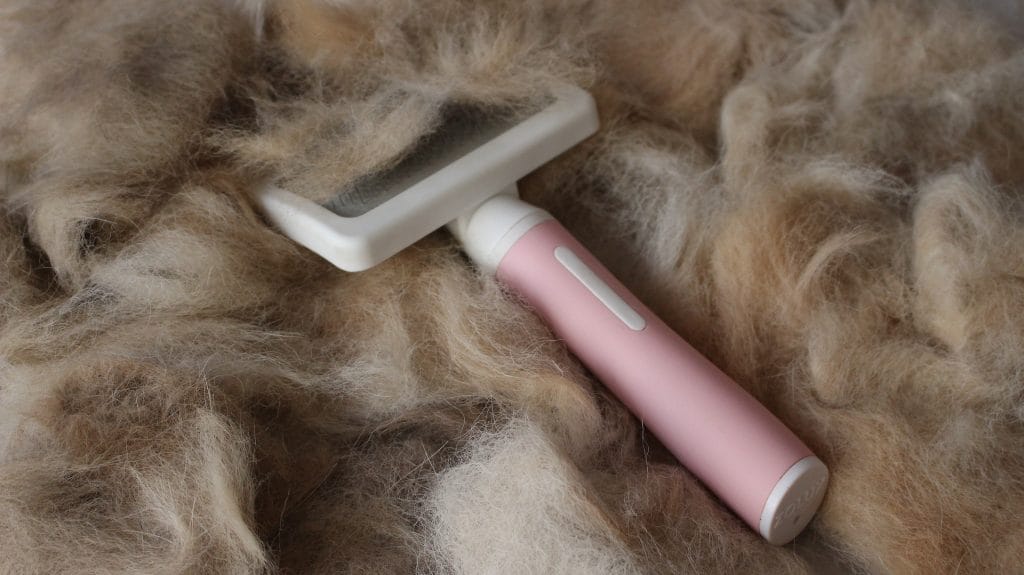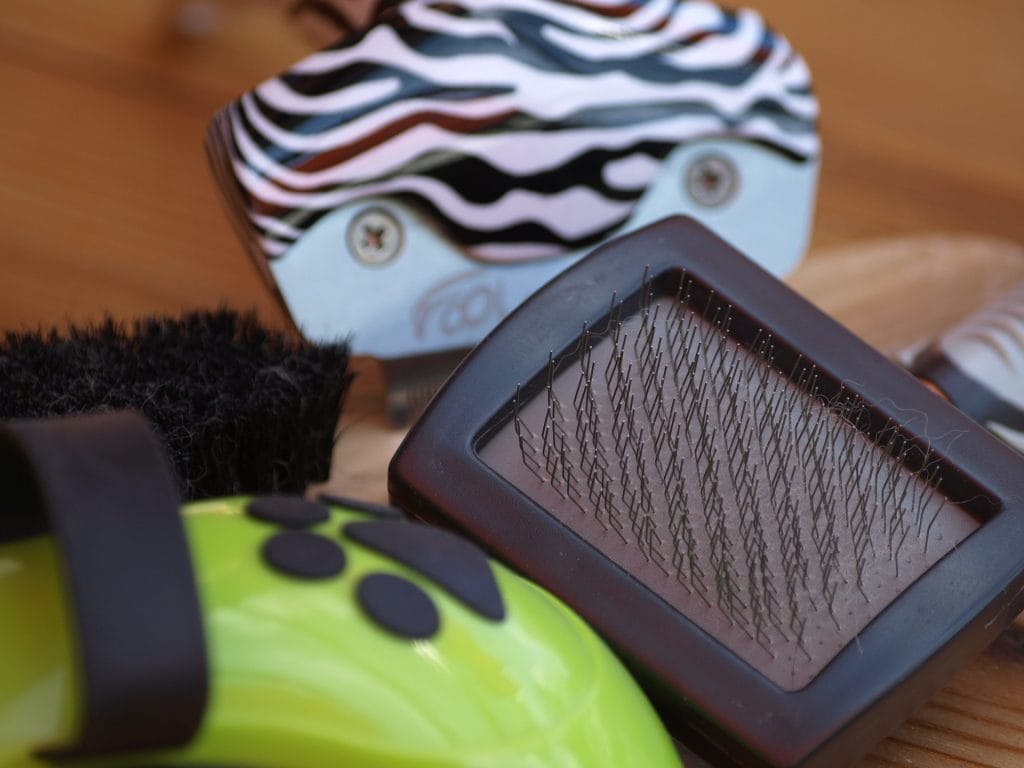Introduction
Hey there, dog lovers! We all know that our furry friends need regular grooming to stay healthy and looking their best. But, with so many different types of coats and brushes, it can be tough to figure out the best approach. In this comprehensive guide, we’ll take you through the ins and outs of brushing your dog’s coat, helping you to keep your pet happy and looking fabulous. Let’s discover how to properly brush your dog’s coat and learn about tools, and techniques to keep your furry friend looking and feeling their best.

Understanding Your Dog’s Coat
Hey there, fellow dog enthusiasts! Let’s have a chat about something we all care about – our dogs’ beautiful coats. It’s important to know what kind of coat your dog has, as it directly affects their grooming needs. So, buckle up, and let’s dive into the fabulous world of dog coats!
A. Smooth Coats
Do you have a Dachshund, Greyhound, or Beagle in your life? These breeds have smooth coats, characterized by short, sleek hair that lies close to the body. Dogs with this coat type tend to be low-maintenance grooming-wise, as their hair doesn’t typically mat or tangle.
However, don’t let the simplicity fool you! Regular brushing with a soft bristle brush will help distribute their natural oils, giving their fur that beautiful shine we all love. Plus, it’s a great way to bond with your dog and keep an eye out for any skin issues.
B. Short Coats
Breeds like the Labrador Retriever, Boxer, and Bulldog boast a short coat. Although these coats are still relatively low-maintenance, the hair is slightly longer and denser than smooth coats. As a result, these dogs may shed more, especially during seasonal changes.
To keep your short-coated dog looking fresh and feeling comfortable, regular brushing is key. A slicker brush or bristle brush will help remove loose hair, and you’ll likely find yourself amazed at how much fluff comes off!
C. Long Coats
If your dog has a flowing mane like the Golden Retriever, Shih Tzu, or Afghan Hound, you’ve got a long-coated companion. These majestic dogs require a bit more effort in the grooming department, as their hair can easily become tangled or matted if not cared for properly.
But hey, we know you’re up for the challenge! Make sure to brush your long-coated dog daily or every other day, using a slicker brush, pin brush, or undercoat rake to detangle and smooth their fur. And don’t forget to pay special attention to areas prone to matting, like behind the ears and under the legs – nobody likes a surprise mat!
D. Curly Coats
Ah, curly-coated cuties! Breeds such as Poodles, Bichon Frises, and Portuguese Water Dogs have coats made up of tight curls or waves. These coats can be a bit trickier to manage, as they’re prone to tangling and matting.
Fear not, though! Regular grooming will keep those curls looking their best. Start by using a slicker brush or comb to gently detangle any knots, followed by a pin brush to fluff and define those gorgeous curls. And remember, patience is key when working with a curly coat – take it slow and steady, and your dog will thank you.
There you have it! By understanding your dog’s coat type, you’re well on your way to becoming a grooming pro.

Choose the Right Grooming Tools
Alright, dog lovers, now that we’ve covered the different types of coats, it’s time to talk about the essential grooming tools to keep our furry friends looking their best. Each coat type has specific grooming needs, so let’s dive into the details to ensure we’ve got the right tools for the job!
A. Slicker Brush
The slicker brush is a staple in any dog grooming kit. It features fine, closely-packed bristles on a flat or slightly curved base. This brush is particularly useful for detangling and removing loose hair from dogs with long or curly coats. It can also be used for short coats to help remove loose hair and prevent shedding. Just remember to be gentle when using a slicker brush, as it can be a bit more aggressive on the skin if not used carefully.
B. Bristle Brush
Featuring soft, natural bristles, the bristle brush is perfect for dogs with smooth coats. It’s gentle on their skin while effectively removing loose hair and dirt. This brush can also be used on short coats to help distribute natural oils and maintain a healthy shine. Bristle brushes come in various bristle stiffness levels, so choose one that best suits your dog’s coat type.
C. Pin Brush
A pin brush resembles a human hairbrush, with long, wire pins set into a cushioned base. This brush is particularly effective for dogs with long, thick coats, as it can easily glide through the hair without causing breakage. Use the pin brush to smooth and finish your dog’s coat after using a slicker brush or undercoat rake to remove tangles and loose hair. Keep in mind that a pin brush is not the best choice for detangling, so use it primarily for finishing touches.
D. Undercoat Rake
If your dog has a double coat (think Siberian Huskies or German Shepherds), an undercoat rake is a must-have tool. This specialized grooming tool has widely spaced teeth designed to remove loose undercoat hair without damaging the topcoat. Regular use of an undercoat rake will help prevent matting and excessive shedding, keeping your dog cool and comfortable.
E. Comb
A stainless steel comb is a versatile addition to your grooming toolkit, especially for dogs with long or curly hair. Use a comb with both wide and narrow teeth to gently work through tangles and remove loose hair. Combs are great for getting into hard-to-reach areas like the face, ears, and paws, where larger brushes might be difficult to maneuver.
F. Detangling Spray
For dogs prone to tangles and mats, a detangling spray can be a lifesaver. These sprays help to lubricate the hair, making it easier to work through knots without causing discomfort to your dog. Simply spray the solution onto the problem area and gently work through the tangle with your chosen brush or comb. There are various options available, including natural, leave-in sprays that can keep your dog’s coat healthy and smelling fresh.
G. De-shedding Tool
De-shedding tools like the Furminator are designed specifically to remove loose hair from the undercoat. These tools have a unique stainless steel edge that reaches deep beneath the topcoat to gently remove undercoat hair without damaging the outer layer. De-shedding tools are particularly useful for dogs with double coats and can significantly reduce shedding when used regularly.
H. Grooming Glove
Grooming gloves are an excellent option for pet owners who want a more hands-on approach to grooming. These gloves have soft rubber bristles or nodules on the palm and fingers that help remove loose hair and dirt from your dog’s coat while petting them. They’re great for dogs with short or smooth coats and can also be used to massage and stimulate circulation in your dog’s skin.
I. Mat Breaker
If your dog is prone to severe matting, a mat breaker or mat splitter is a valuable tool to have on hand. These tools have sharp, serrated blades designed to cut through mats safely without harming your dog’s skin. Be sure to use caution and work slowly when using a mat breaker, as improper use can result in injury to your dog.
J. Flea Comb
A flea comb has very closely spaced teeth designed to remove fleas and their eggs from your dog’s coat. These combs can also help remove debris, dirt, and dandruff. Regular use of a flea comb can aid in early detection of fleas, helping you to address the issue before it becomes a more significant problem.
K. Thinning Shears
Thinning shears are scissors with a serrated edge on one blade, which can be used to thin out and blend your dog’s coat, particularly for long-haired breeds. These shears are also useful for trimming around the face and ears without creating a blunt, unnatural look. Remember to use thinning shears sparingly and only as needed to avoid over-thinning your dog’s coat.
L. Nail Clippers or Grinder
While not directly related to brushing your dog’s coat, maintaining proper nail care is essential for their overall health and comfort. Choose between scissor-style or guillotine-style nail clippers, or opt for a nail grinder, which files down the nails gradually. Make sure to trim your dog’s nails regularly, and be cautious not to cut the quick (the blood vessel inside the nail), as this can be painful and cause bleeding.
Now that you’re well-equipped with the right grooming tools, you’re all set to brush any dog coat that comes your way! Happy grooming!
Preparing for the Brushing Session
Alright, my fellow dog devotees, we’ve explored coat types and assembled an impressive array of grooming tools. Now it’s time to get ready for the main event: the brushing session! But don’t worry, we’re here to walk you through the process and make it as enjoyable as possible for both you and your canine companion. So let’s get started, shall we?
A. Find the Perfect Spot
First things first, let’s choose a comfortable, quiet space with good lighting for your grooming sessions. Whether it’s your living room floor, a grooming table, or even your backyard, find a spot where your dog feels relaxed and secure. Remember, the more at ease your dog is, the smoother the grooming process will be. So, make sure you pick a place that’s free from distractions and noise to set the stage for a pleasant experience.
B. Gather Your Grooming Gear
Now that you’ve got your grooming station all set up, it’s time to gather your tools. Brushes, combs, detangling spray, scissors – you name it! Keep everything organized and within reach so that you don’t have to interrupt your bonding time to search for that elusive comb.
C. Set the Mood
Before diving into the brushing session, take a moment to make sure your dog is in the right frame of mind. Some calming background music or a few drops of lavender essential oil in a diffuser can help create a soothing atmosphere for your dog. Giving your dog a gentle massage or a few minutes of petting can also help them relax and associate grooming with positive experiences.
D. Introduce Your Dog to the Tools
If your dog is new to grooming or a bit nervous about the process, it’s essential to introduce them to the grooming tools gently. Let your dog sniff and inspect the tools before using them. Pair the introduction with lots of praise and treats to create positive associations with grooming. Remember, patience is key – it might take a few sessions for your dog to feel comfortable with the process.
E. Brush up on Your Brushing Technique
Before you begin, make sure you know the proper brushing technique for your dog’s coat type. Hold the brush at a slight angle and use gentle, even strokes, always brushing in the direction of hair growth. Be mindful of sensitive areas like the face, ears, and belly, and always be gentle when working through tangles to avoid causing discomfort.
F. Take It Slow
During the grooming session, keep an eye on your dog’s body language and comfort level. If they become anxious or uncomfortable, take a break, offer reassurance, and try again later. Remember, it’s essential to make grooming a positive experience for your dog, so be patient, use plenty of praise and treats, and take it one step at a time.
With these tips in mind, you’re all set to create an enjoyable, stress-free brushing session for both you and your dog.

Brushing Techniques for Different Coat Types
Hey there, fellow dog lovers! Now that you’re all prepped and ready to tackle your dog’s grooming needs, let’s talk about brushing techniques for different coat types. From smooth to curly, each coat type requires a unique approach, so let’s make sure we’re brushing like pros, shall we?
A. Smooth Coats
Dogs with smooth coats, like Dachshunds and Greyhounds, have it pretty easy in the grooming department. To keep their fur looking sleek and shiny, use a soft bristle brush and gently brush in the direction of hair growth. You’ll want to cover their entire body, but pay extra attention to areas that tend to shed more, like the neck and rump. A quick brushing session once or twice a week should do the trick, and don’t forget to give them plenty of praise along the way!
B. Short Coats
For our short-coated friends like Labradors and Boxers, a slicker brush or bristle brush works best. Start by brushing against the direction of hair growth to help loosen any dead hair, and then follow up by brushing in the direction of hair growth to remove any loose hair and debris. Aim for weekly brushing sessions to keep shedding under control, and feel free to throw in a grooming glove for some extra bonding time with your pup.
C. Long Coats
Now, for our long-coated beauties like Golden Retrievers and Shih Tzus, a little extra TLC is needed. Begin by using a slicker brush or an undercoat rake to gently work through any tangles and remove loose hair, always brushing in the direction of hair growth. After detangling, follow up with a pin brush to smooth and finish the coat, paying extra attention to those pesky mat-prone areas like behind the ears and under the legs. Daily or every-other-day brushing is ideal for these glamorous canines to keep their flowing locks looking fabulous.
D. Curly Coats
Last but not least, let’s talk about those adorable curly-coated pups like Poodles and Bichon Frises. Their unique coat texture can be a bit challenging, but we know you’ve got this! Start by using a slicker brush or comb to gently detangle any knots, always working in the direction of hair growth. Once you’ve conquered the tangles, follow up with a pin brush to fluff and define those bouncy curls. Remember, patience and a gentle touch are key when working with curly coats, so take it slow and steady. Aim for daily or every-other-day brushing sessions to keep those curls looking their best.
And there you have it! By mastering these brushing techniques, you’ll be well on your way to ensuring your dog’s coat stays healthy, tangle-free, and fabulous. So grab your brushes and let’s get to work! Happy brushing!
Conclusion
Well, dog enthusiasts, it’s been quite the adventure, hasn’t it? We’ve explored the world of diving deep into coat types, grooming tools, and brushing techniques to ensure our canine companions are always looking their best. More importantly, we’ve learned how to brush our dog’s coat. It’s about keeping our beloved pups healthy and happy too.
As you embark on your grooming journey, remember that patience, love, and consistency are key. Take the time to create positive grooming experiences for your dog, and watch as the bond between you two grows even stronger. After all, there’s nothing better than a happy, healthy, well-groomed dog, right?
So grab your brushes, roll up your sleeves, and get ready to show your furry friend just how much you care. Because at the end of the day, a well-groomed dog is a happy dog, and that’s what it’s all about. Happy grooming, fellow dog lovers!

